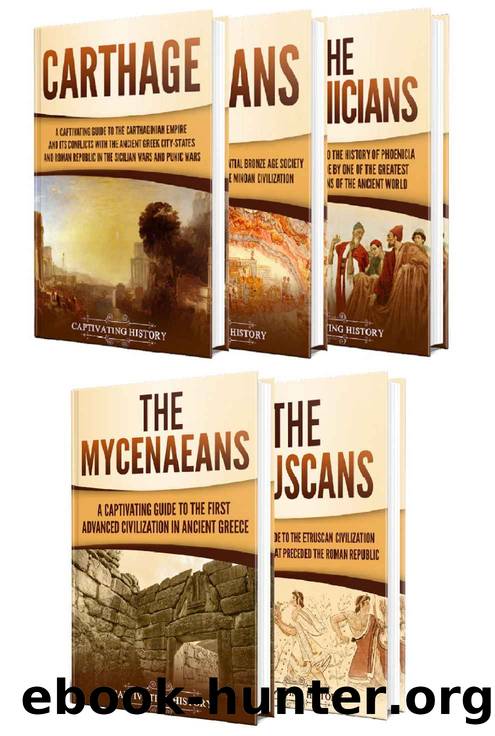Ancient Mediterranean Civilizations: A Captivating Guide to Carthage, the Minoans, Phoenicians, Mycenaeans, and Etruscans by Captivating History

Author:Captivating History [History, Captivating]
Language: eng
Format: azw3
Published: 2020-06-01T00:00:00+00:00
These periods demonstrate when the Phoenicians first emerged as a distinct culture, when they started to become an independent power, their golden age, their subjugation under the Assyrians, becoming vassals of the Babylonians, then serving the Persians, the conquest of Alexander the Great, and their eventual fall to Greek and Roman influence and power. Throughout this time, the society and culture of the Phoenicians underwent numerous changes, especially in terms of technology, trading power, artistry, and political structure. However, only a few of these developments are left for posterity.
The Late Bronze Age
The Phoenician story begins when they were just starting to distinguish themselves from their predecessors and cousins, the Canaanites. Around this time, the native peoples of the Levant started to gravitate toward large coastal cities that offered opportunities for wealth, security, regular work, and culture. Some of the largest were Byblos and Tyre, which would go on to become two of the most successful Phoenician city-states. Individuals in these urban centers carved a niche for themselves by becoming intermediaries in the trade between Egypt and the nearby Syrian states, helping to form the tradition of the Phoenicians as traders.
However, it can be difficult to distinguish when Canaanites started to become Phoenicians. Could someone be a Canaanite and a Phoenician? Could someone be a Phoenician yet still be a Canaanite? The definite answer is sort of. Being Phoenician required having Canaanite heritage, living in the Near Eastern region, and participating in a new twist on religion and language. Someone could be a Canaanite and a Phoenician, but it would be difficult for a Phoenician to not be a Canaanite.
Before c. 1230 BCE, the Canaanites were in their own golden age, which is a term that refers to when culture, trade, and society flourish. This came to a grinding halt during the Bronze Age Collapse when a mysterious force decimated the city of Ugarit, leaving the region abandoned. At the same time, the nearby Israelites invaded and attempted to take arable farmland, while the mysterious Sea Peoples from the west arrived and started laying waste to anyone who stood in the way of total conquest. The Philistines moved in, claiming southern Canaanite cities as their territory.
To add fuel to the fire, the Near East experienced a surge of unfavorable environmental factors, including a prolonged drought. The ensuing famine led many to abandon cities in search of natural resources like wild vegetation and fresh water. The political structure of the central city died out, leaving the Canaanites to become more nomadic. The ensuing chaos called for a complete reordering of society, and when the dust fell, a new power known as Phoenicia emerged from the Canaanite survivors, becoming an independent region on the coast.
Iron Age I
Unfortunately, few sources remain to inform modern scholars about life in Phoenicia during the 12th century BCE, although some evidence indicates the cities of Byblos and Sidon were able to rapidly recover from the economic devastation of the Bronze Age Collapse. These cities would become central to
Download
This site does not store any files on its server. We only index and link to content provided by other sites. Please contact the content providers to delete copyright contents if any and email us, we'll remove relevant links or contents immediately.
| Africa | Americas |
| Arctic & Antarctica | Asia |
| Australia & Oceania | Europe |
| Middle East | Russia |
| United States | World |
| Ancient Civilizations | Military |
| Historical Study & Educational Resources |
The Daily Stoic by Holiday Ryan & Hanselman Stephen(3110)
The Fate of Rome: Climate, Disease, and the End of an Empire (The Princeton History of the Ancient World) by Kyle Harper(2875)
People of the Earth: An Introduction to World Prehistory by Dr. Brian Fagan & Nadia Durrani(2619)
Ancient Worlds by Michael Scott(2493)
Babylon's Ark by Lawrence Anthony(2433)
Foreign Devils on the Silk Road: The Search for the Lost Treasures of Central Asia by Peter Hopkirk(2388)
The Daily Stoic by Ryan Holiday & Stephen Hanselman(2344)
India's Ancient Past by R.S. Sharma(2298)
MOSES THE EGYPTIAN by Jan Assmann(2275)
The Complete Dead Sea Scrolls in English (7th Edition) (Penguin Classics) by Geza Vermes(2135)
Lost Technologies of Ancient Egypt by Christopher Dunn(2111)
The Earth Chronicles Handbook by Zecharia Sitchin(2101)
24 Hours in Ancient Rome by Philip Matyszak(1973)
Alexander the Great by Philip Freeman(1961)
Aztec by Gary Jennings(1879)
The Nine Waves of Creation by Carl Johan Calleman(1784)
Curse Tablets and Binding Spells from the Ancient World by Gager John G.;(1768)
Before Atlantis by Frank Joseph(1740)
Earthmare: The Lost Book of Wars by Cergat(1715)
